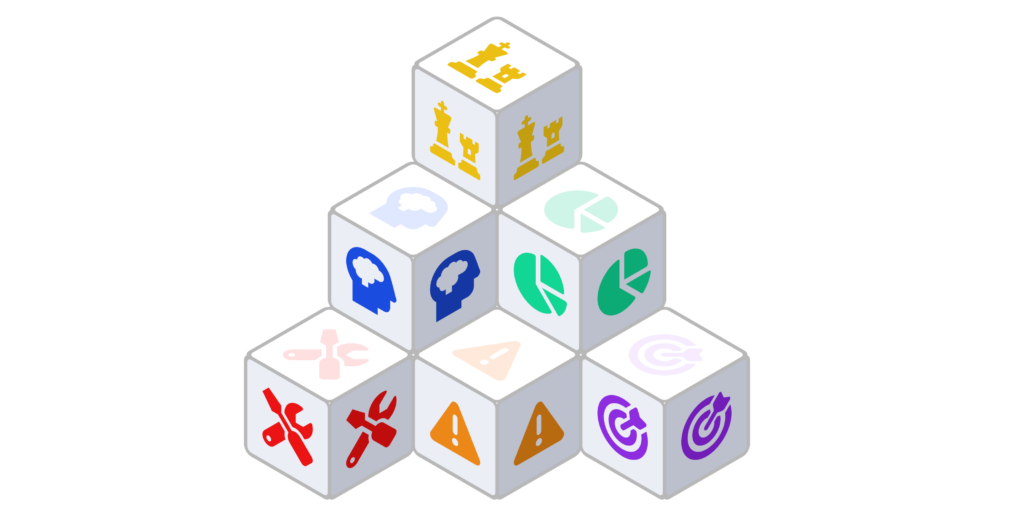
Get Started
Graphite's supplier management tool helps you onboard faster, cut time on risk reviews and streamline supplier validations. Save time and money.
July 31 2023
The Ultimate Procurement Transformation Roadmap with Challenges, Strategy and Best Practices
Ready to move forward with your digital procurement transformation projects? Effective leadership and strategic thinking are the secret sauce to making your digital transformation a success. However, it’s too easy to miss out on the full potential of your shiny, new tech stack addition if key elements like user adoption, procurement process design, and procurement strategy aren’t given the attention they deserve.
We had the chance to interview Amanda Prochaska, Founder and Chief Wonder Officer at Wonder Services, and Conrad Smith, CEO of Graphite, about their learnings from over 50 years of collective experience in procurement operations.
Here, they’ve shared valuable insights, including three common pitfalls to digital procurement transformation and tips on how to develop a procurement transformation strategy so your project goes as smoothly as possible We’ve collated all these insights into a single procurement transformation roadmap to make it easier for you to kickstart your own.
Challenges Every Procurement Transformation Roadmap Has to Overcome
Users Not Adopting New Technologies

Procurement technology is becoming easier to implement, but getting users to adopt it is still challenging.
“Sometimes you say user adoption, and people think it’s simply training and communication or that you’re basically going to tell them what to do, and they’re going to do it magically,” says Amanda Prochaska, Founder of Wonder Services, a consulting firm that focuses on streamlining the procurement process. “But to get user adoption [of digital technologies], you must think about your process design, the procurement strategy and data around it, and your culture.”
Lack of Digital Procurement Strategy

As a procurement leader, you may be tempted to buy new technologies just because everyone else is, but it’s essential to think about what you want to accomplish. What’s the big picture around the whole procurement transformation strategy you’re trying to drive?
You may already have a digital procurement strategy in mind with very different components, such as contract management and supplier onboarding. To succeed, you must be able to integrate and communicate how each of these separate components contributes to the overall strategy and business objectives throughout the implementation process.
“If you can put a bow around it and describe what you’re trying to achieve, the overall benefits to the supplier, and the different components it’s comprised of, [the procurement transformation project] will go much more smoothly,” recommends Prochaska.
Take a step back and ask yourself, what end game are you trying to achieve? How will you measure it? As you describe your different initiatives, tie them back to these goals and metrics, and make sure your team also sees your digital transformation vision since they’ll be the ones doing the work.
No One Leading the Procurement Transformation Project

Another dangerous pitfall is when procurement leaders hand off digital transformation projects to system integrators (SIs).
An SI’s job is to get the system up and running—not to transform the business. You’re not genuinely transforming your business when focusing only on implementing the technology. You’re simply connecting the dots.
“If you want a technology deployed, you can have your SI do it. But if you want to transform your business, you must lead it,” says Prochaska. “At the end of the day, you know your business, you know what the outcomes are, and you are the one in charge of transforming your business, not just implementing the technology.”
Your Procurement Transformation Roadmap: From Birth to Success
Develop your Procurement Transformation Strategy

Before plunging headfirst into your digital procurement transformation design, building a solid case for the change is crucial. By gaining the buy-in and support of your key stakeholders, you set the stage for successful implementation and outcomes. The following tips can help you effectively build a procurement transformation strategy that will argue your case for change:
Assess the Risks of Your Digital Transformation Project
Take a moment to evaluate the organizational and cultural risks that may lie ahead. Are there multiple projects vying for attention? Do you have a supportive leader by your side? Addressing these critical questions will pave the way for a smoother journey and ensure your procurement transformation efforts receive the backing they deserve.
“There are all kinds of risks that you must assess before you dive into the [procurement transformation] project,” says Prochaska. “We call it building the case for change—that whole foundation for change that needs to happen before you dive in. And most people skip right over it.”
Start by thoroughly assessing the current state of your organization, business processes, and systems. Identify the risks, challenges, and limitations that require a change.
Identify Your Procurement Transformation Objectives
Define a vision for your company or the specific area that requires change. What are your objectives, and how will the proposed digital transformation help you achieve them? Consider opportunities for improved efficiency and business agility, cost savings, or a better customer experience. Communicate the benefits of procurement transformation to your organization and stakeholders.
“Design with the outcome in mind instead of just the delivery. What are you trying to accomplish here?” advises Conrad Smith. “The tools should enable the outcome that matters to you—the business outcome, the goals, the vision, all of that needs to be clear.”
Define Your Success Metrics for Procurement Performance
A well-thought-out procurement transformation strategy needs success metrics to show your progress and help you stay focused on the end game. It’s not just about return on investment. There are other metrics in the business that you should measure to ensure you’re getting maximum value from your new technologies.
For one, metrics must be connected to the core business objectives. That means thinking about more than just outcomes. Look at your entire procurement function and team from a high level and determine what you want to measure. From that vantage point, you can invest in those projects that improve the two or three outcomes that matter most to your procurement team and overall business agility.
A project will always have hiccups when things don’t go as planned. Success metrics support the project, allowing you to clearly demonstrate to stakeholders areas where you are doing well.
Metrics help with the overall management of expectations internally and with strategic design decisions. For example, say one of your success metrics is that documented purchase orders fully support 100 percent of all Procure-to-Pay(P2P) transactions. That success metric will drive your activities throughout the project, including any design and policy decisions.
Examples of Success Metrics for Procurement Departments
Depending on your objectives, you can use many success metrics. A few include:
- Average cycle time of purchase requisition to purchase order (P2P)
- Net promoter score
- Spend under management savings
Prochaska recommends focusing on at most four to six metrics.
Why Procurement Teams Should Avoid Certain Metrics
In the procurement process, it’s essential to understand when the outcome should be connected to spend and when it should be connected to transactions.
For instance, if e-invoicing is one of your metrics, you want to measure it by something other than spend. The whole point of e-invoicing is to get away from manual procurement processes. Sometimes people get so focused on spend they forget that what they’re trying to measure is a reduction in manually-operated processes. In this case, you should look at the percentage of transactions rather than spend.
Be Aware of How Metrics Drive Behavior
What gets measured gets done. That’s why it’s essential to measure what you’re doing in a particular area to make sure it’s driving the behavior you want.
Prochaska cites an example of how her organization created a metric around the cycle time between creating a goods and services purchase requisition to the purchase order. Automated transactions were excluded from the metric. That meant the transaction wasn’t counted if the company bought from a catalog in someone else’s cycle time.
However, excluding these automated procurement processes from the metric resulted in buyers not being incentivized to buy more on the catalog. Once this changed to include process automation, buyers were motivated to buy from the supply chains on the catalog again. This small change streamlined the procurement process by providing pre-negotiated supply chain options, standardized pricing, and electronic purchasing. Be sure to think through the consequences of each metric that you set.
Focus on Procurement Transformation Best Practices
Procurement teams must leverage effective procurement transformation best practices rather than just “winging it.” Conrad learned this directly when implementing Ariba for Intel in the late ‘90s.
“The leadership team brought a PWC project manager onboard to assist. At first, it drove me crazy,” says Smith. “I wanted to get started on the project, and here we were burning $300/hour for a couple of weeks just planning out the project! Communications, decision making, issue management. All things I thought were very straightforward. The hourly cost was giving me stress and anxiety.”
The project was not only a huge success for the small project team, but was also a big win for Intel procurement, IT, and Ariba. So big, in fact, that IT leadership promoted Smith from the 20-person Ariba project to lead a flailing 200-person SAP implementation project.
“The stakes couldn’t be higher for me and the broader organization. It was pretty obvious from day one that the SAP project lacked those basic project management infrastructure elements that the project manager had helped me learn and implement 12 months earlier,” says Smith.
By going back and retrofitting the project with these key foundational elements, his team turned the project from spinning and high risk to another great success for the company.
“Without a doubt, the investment with a project manager on the Ariba project was a huge lesson for me of the importance of the basics. Beyond the success with the Ariba project, well-paid tuition has guided my approach to many more projects since then.”
Consider the following procurement transformation best practices to enhance your procurement team’s project management capabilities, process efficiency and achieve better outcomes:
Thorough Planning for Digital Procurement Solutions
First, prioritize thorough planning. Take the time to develop a detailed project plan that covers everything from objectives and timelines to resource requirements. This will provide a clear procurement transformation roadmap for your procurement team, enabling them to anticipate and tackle potential challenges and mitigate risks effectively.
Effective Issue Management
When it comes to issue management, don’t shy away from it. Hiccups in your procurement processes happen along the way, but the key is to address them head-on. Encourage your procurement team to identify and deal with issues promptly. Set up a system to track and prioritize those problems, assign responsibilities, and monitor their resolution. Doing so will avoid unnecessary delays and keep your project on track.
Transparent Communication
Communication is the glue that holds everything together. Foster an open and transparent environment where everyone feels comfortable sharing information. Regularly update your team, stakeholders, and partners on project progress, milestones, and any changes. And be sure you have a solid communication plan in place. That means clear channels, frequency, and knowing who needs to be in the loop.
Well-Defined Decision-Making
Informed decision-making is crucial. Having a clear procurement process is better than making decisions on the fly. Define roles and responsibilities within your team and assign decision-makers for different aspects of the project. Create frameworks considering cost reduction, quality, risk, social and environmental responsibility, and stakeholder impact. By streamlining your decision-making process, you’ll avoid confusion and keep things moving smoothly.
Success Criteria
Encourage a culture of continuous improvement. Take the time to evaluate your project’s performance and learn from wins and setbacks. Conduct post-project reviews to identify areas where you can do better next time. Be open to making adjustments and adapting your plans along the way. With this mindset, you’ll constantly improve your project management practices and achieve better outcomes.
By investing in these project management best practices, you can avoid the pitfalls of “winging it” and be well on your way to achieving project success.
Get Leaders to Buy into your Procurement Transformation Roadmap
Smith says one of the most significant determinations of success is having someone at the leadership level actively taking responsibility for the project. So get key leaders and decision-makers involved from the start.
“Ninety percent of the time when people contact us post facto and say, ‘This didn’t go so well. The technology’s not working for us, or it wasn’t adopted,’ one of the main factors is because the leader was not truly involved,” says Prochaska.
Assess Your Skill Set for a Digital Transformation in Procurement
Studies show that procurement professionals recognize the importance of digital transformation, but many feel they need more skills and resources to execute one fully.
This may be due to fear or overwhelm: What happens if something goes wrong? What if there are integration issues? What are the questions I should be asking? And who do I ask?
“I think it’s really smart to think about that as a leader—do I have the skill set to do this?” Prochaska recommends. “And if you don’t, develop a role like that where you can hire someone to be that person.”
Build a Team of People Smarter Than You to Fuel Your Digital Procurement Strategy
When building your dream team, surround yourself with individuals who are smarter than you. This includes team members who bring innovative ideas and a willingness to learn and apply their skills to the project. Also, consider people who are from other teams or who have prior experience in similar procurement transformation projects. Consider bringing in team members with a digital transformation background, even if they lack procurement experience, to complement your skills and knowledge of the company.
Recognizing and actively filling the gaps in your team is crucial for success. Returning and delegating instead of doing a gap assessment of the situation is easy. Ask yourself, “Where do I need more talent? Where do I need more training?” Then, “start investing in yourself and your team to fill in those gaps,” says Smith. “Instead of retreating behind something, be the front leader to keep it moving forward.”
Lead with Confidence

Doing justice to your procurement transformation roadmap boils down to tackling common hurdles like getting users on board, designing efficient procurement processes, having a solid procurement transformation strategy, and, most importantly, stepping up as a leader. Don’t just follow the crowd. Instead, buy new technologies with a clear procurement strategy and purpose. Build a strong case for digital transformation by taking the time to identify risks, envision your end game, and tie it to measurable goals. Get your team and stakeholders involved, fill any skill gaps, and show up as a leader. By avoiding these pitfalls, you’ll drive your procurement transformation like a pro!
Interested in Learning More?
At Graphite Connect, we’re passionate about empowering procurement and strategic sourcing teams to excel. Our proven supplier lifecycle and risk management tool can help you transform your supplier management and procurement processes from inefficient, manually-operated processes to a streamlined, end-to-end digital procurement solution that saves you time and money.
Learn More